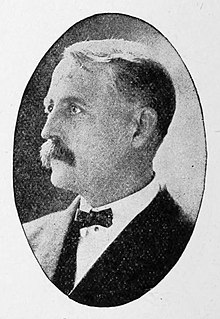Doane Robinson | |
|---|---|
 Robinson c. 1915 | |
| Born | Jonah LeRoy Robinson October 19, 1856 Sparta, Wisconsin, U.S. |
| Died | November 27, 1946 (aged 90) Pierre, South Dakota, U.S. |
| Occupation | Historian |
| Known for | Original idea for Mount Rushmore |
Jonah LeRoy "Doane" Robinson (October 19, 1856 – November 27, 1946[1]) was an American historian who was the state historian of South Dakota. He is known for conceiving of the idea for the Mount Rushmore National Memorial in the Black Hills, which he believed would stimulate tourism to the area.
Doane Robinson had introduced a bill to the South Dakota Legislature asking for permission and funds to scout a location for a massive carvings project; the sculpture was to include the Sioux Nation chief as well as local famous South Dakotans. While denied funding, he was granted permission to look for an area.
He had initially suggested a well-known area of the Black Hills, Needles, named after large distinct eroded granite pillars.
Early on, Robinson originally wrote Lorado Taft about the project idea and potential Needles location. At the time Taft was quite ill and unable to attend any expedition to survey the area.
Not giving up, in September 1924 Robinson met with Gutzon Borglum, writing Borglum about the potential project. During Robinson and Borglum's first expedition to the Needles, Borglum declared his dislike of Robinson's proposed location because of the soft rock and controversy attached to it by the Lakota Nation.
In August 1925, Borglum had made a second trip to South Dakota and declared Mount Rushmore would be the site of this grand Sculpture project. Doane Robinson, then 69 years old, joined an expedition party in scaling the mountain. He became the de facto project manager of the Rushmore Memorial from that point on.
Robinson gained support from then US Senator, Peter Norbeck from South Dakota, and in 1929, during the last months of his presidency, President Calvin Coolidge approved the project after Congress authorized funding. The project was completed in 1941. Doane Robinson lived to 1946, seeing his idea fully completed.
- ^ Hoover, Herbert T., & Larry J. Zimmerman (eds.). 1989. South Dakota Leaders: From Pierre Chouteau, Jr., to Oscar Howe. Vermillion: University of South Dakota Press, p. 439.